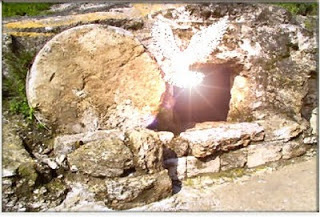 Check out the Minimal Facts approach to the Resurrection of Jesus of Nazareth. Mary Jo’s Power Point presentation is an easily accessible resource for you to learn or share with others. The Power Point presentation was put together in 2007 along with a few blogs on the minimal facts in February, March and April of the same year.
Check out the Minimal Facts approach to the Resurrection of Jesus of Nazareth. Mary Jo’s Power Point presentation is an easily accessible resource for you to learn or share with others. The Power Point presentation was put together in 2007 along with a few blogs on the minimal facts in February, March and April of the same year.
“More than that, we are then found to be false witnesses about God, for we have testified about God that he raised Christ from the dead.” I Corinthians 15:15
Share this with your friends, family, skeptics…
Click here for the presentation.
Roger


Much of these arguments are like claiming that the land of Oz must exist because otherwise how do we explain the yellow brick road? There are fictional elements throughout the story. It's only difficult for the skeptic if we assume we're dealing with facts.
Take the women at the tomb. That might be a problem if Mark was trying to be persuasive. What if he's trying to tell a story he knows to be fictional? Is C.S. Lewis ashamed that young children are the first to discover Aslan is resurrected even though children are not always reliable? Should we believe Aslan is resurrected?
Mark sure looks like fiction. You know why J.K. Rowling knows exactly what Harry might be saying even if he's all alone? She's the narrator. How does Mark know what Jesus said in Gethsemane when he was a good distance from all the disciples and they were falling asleep? He's a fictional narrator. How does Mark know about the conversation Jesus had with Pilate? He's a fictional narrator.
If you doubt Mark is willing to make stuff up have a look at chapter 7 where he puts in the mouth of Jesus an argument that depends on an incorrect translation in the Septuagint, a text that would hardly be used by Aramaic speakers in Palestine and would hardly fool the Pharisees. I detail this here.
Mark tells stories that make no sense as history but perfect sense as symbolic myth. Take the story of Barabbas. The name means "son of the father" in Hebrew. The Jews had a custom of taking two goats as punishment for sin. One would have hands laid on it, the sins of the people, and it would be released to the wild to fend for itself. The other would be taken off for slaughter. So here we have one "Son of the father", namely Jesus, and the other, Barabbas. One released to the wild as the scape goat. The other killed. Makes perfect sense as symbolic myth. The idea that Pilate would release a convicted insurrectionist under any circumstances seems extremely implausible.
Mark makes things up and probably thinks the reader recognizes that's what he's doing. The women at the tomb is more of the same.
Have a nice Easter break
Peace
Accusations such as Jon's above overflow with desperation and anger. Mad dog atheists and their ilk seethe with a distemper that plain, plain as the fallicies in their arguments.
Barabbas is not a strange or "coincidental" name. What if his name was BarCephas or BarJohn or BarJudas or BarMatthew or heaven forbid BarJoseph. All these are common names, all could be construed as "coincidental" to the story.
As for these claims that the stories are purposefully fcition-sounding, I would say that it is obvious to all rational Biblical scholars that these stories were passed down via oral tradition, not authored by single creative individual. This would mean that the community would filter out such truely fictional notions, like the talking cross or Christ as a child making a clay pigeon come alive. Another argument in the dust pan…
As for the Septuagent charge, Jon is letting his emotions pervert his thinking. The actual difference between the Greek and the Hebrew is very "little", as Jon states in his own sourced blog entry. Jon's anger has clouded his mind. Jesus point stands.
The web is full of these silly arguments, and those who create sound rebuttals. but we are getting to a point where the skeptics are so shrill that any practical argument is impossible. Their rabid hatred for Christianity the light is so plain that as we answer their arguments, we must realize that they are sad and empty, filling that hole in their soul with more darkness. It can be addicting.
The solution: remain in Christ. His is the life. He is the light.
As to how we know the location of Jesus and what was said at meetings with governemnt leaders, might I suggest that during Jesus' time on earth after his resurrection, He told his disciples of these events.
I know that isn't very complex or intellectual, but it does answer the question.
And may I add that phrases like "seems" or "unlikely" are textbook examples of subjective rhetoric, and are of no use in a discussion of the issues. It does reveal the prejudices of the commentor, though. We should not mistake atheist crusading for impartial discussion of the issues.
I suggested five books to Mary and she graciously said she would take a look at them:
http://edward-t-babinski.blogspot.com/2010/04/five-books-every-christian-should-read.html
But I also have two pieces online on the resurrection, one was the last letter in an exchange I had with Dr. Habermas on the resurrection:
http://www.users.globalnet.co.uk/~slocks/asym/babinski-jordan/2.html
The second is a newer piece, on the Growth in the Number of Words Spoken or Attributed to the Resurrected Jesus:
http://edward-t-babinski.blogspot.com/2010/03/word-about-growing-words-of-resurrected.html
Thanks Mary, Hope to speak with you in future.
Ed Babinski (agnostic, editor of Leaving the Fold: Testimonies of Former Fundamentalists)
http://www.edwardtbabinski.us/leaving_the_fold/babinski_agnosticism.html